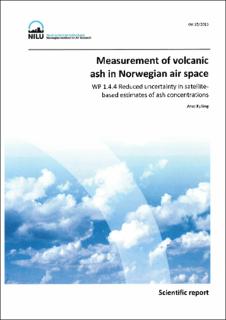Measurement of volcanic ash in Norwegian air space. WP 1.4.4 Reduced uncertainty in satellite-based estimates of ash concentrations.
| dc.contributor.author | Kylling, Arve | |
| dc.date.accessioned | 2020-12-11T13:17:05Z | |
| dc.date.available | 2020-12-11T13:17:05Z | |
| dc.date.issued | 2013 | |
| dc.identifier.isbn | 978-82-425-2649-6 | |
| dc.identifier.issn | 0807-7207 | |
| dc.identifier.uri | https://hdl.handle.net/11250/2718835 | |
| dc.description.abstract | Satellite-based measurements of volcanic ash give the total amount of volcanic ash per area, typically in units of grams of volcanic ash per square meter. To convert this to concentration the vertical thickness of the ash cloud is needed. The ash cloud thickness is not available from passive remote sensors, e.g. IR-sensors, but may be obtained from ground- and space-based lidars. Dispersion models will also provide information of the ash thickness. This report gives an overview of volcanic ash cloud thickness as observed by space, aircraft and ground-based lidars. Also, ash cloud thickness as simulated by the Flexpart particle dispersion model is analysed. The impact of varying cloud thickness on the signal measured by IR-sensor in space is investigated. Focus is on the Eyjafjallajokull 2010 eruption for which a unique wealth of data are available. | |
| dc.language.iso | eng | |
| dc.publisher | NILU | |
| dc.relation.ispartof | NILU OR | |
| dc.relation.ispartofseries | NILU OR;35/2013 | |
| dc.subject | Radiative transfer | |
| dc.subject | Atmosfære og klima | |
| dc.subject | Vulkaner og aske | |
| dc.subject | Modellering | |
| dc.subject | Aerosoler/partikler | |
| dc.subject | Fjernmåling | |
| dc.subject | Volcanic ash | |
| dc.subject | Remote sensing | |
| dc.title | Measurement of volcanic ash in Norwegian air space. WP 1.4.4 Reduced uncertainty in satellite-based estimates of ash concentrations. | |
| dc.type | Research report | |
| dc.rights.holder | © NILU | |
| dc.source.issue | 35/2013 | |
| dc.relation.project | NILU:112109 |
Tilhørende fil(er)
Denne innførselen finnes i følgende samling(er)
-
NILU oppdragsrapport (1970-2015) [1724]
Rapporter i den avsluttede serien NILU oppdragsrapport (NILU OR).
